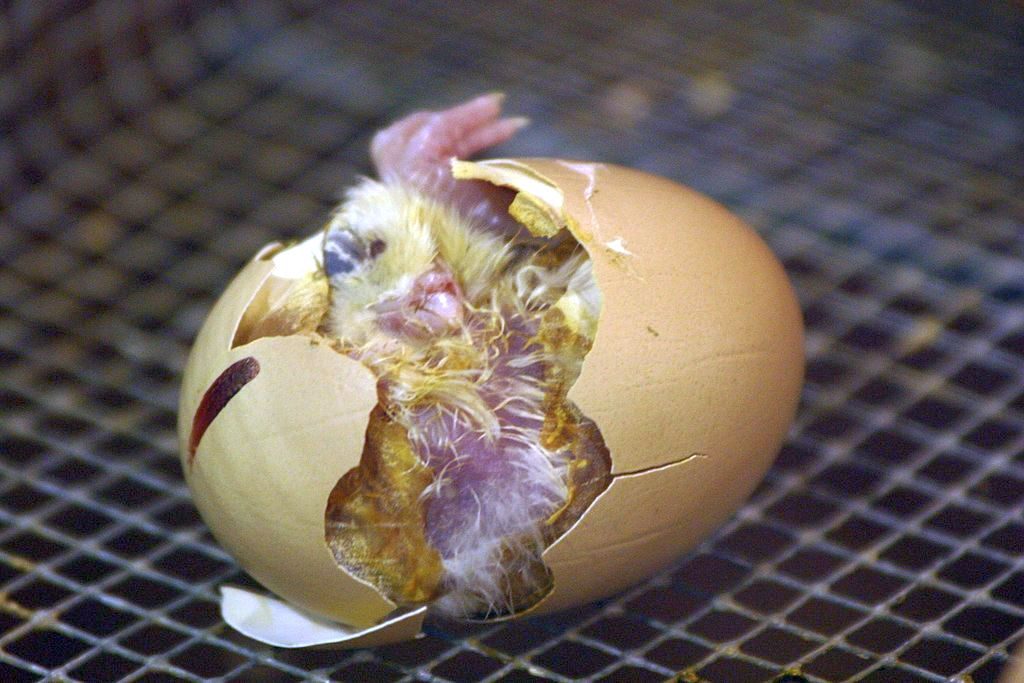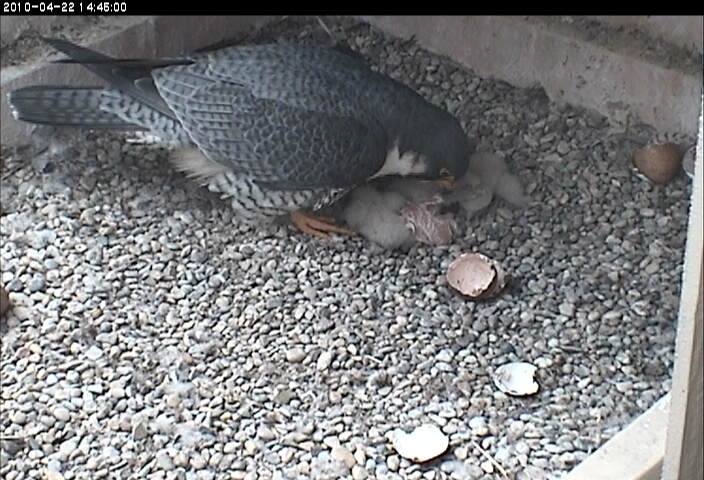
Now that the peregrine falcon eggs are ready to hatch: How does the baby bird get out of the egg? How long does it take from pip to hatch?
Hatching is a strenuous process in very tight quarters. In all bird species it is the chick’s responsibility to get out of his shell, the first big test of his life. His parents do not assist. (Read more here.)
Peregrine falcon chicks take up to 72 hours from pip to hatch with a lot of resting between activities. Here’s what happens:
- Absorb the yolk: Just before hatch day the chick fully absorbs the remaining yolk inside the egg. The yolk was its food during incubation.
- Get into position: Inside the egg the chick pulls himself into a tuck with his beak sticking out between his body and right wing. This gives him the leverage he needs to whack at the shell.
- Communicate with parents and siblings: The chick peeps inside his shell and his pecking makes noise. His parents know which eggs are alive and his siblings can hear that a chick is ready to emerge.
- From Birds of the World, peregrine falcon account: An observer in a nearby blind, “Nelson could hear chick peeping inside egg before hatching began, becoming louder during hatch; initial pip of shell occurred >72 h before chick broke free completely. In 500 artificially incubated eggs of F. p. anatum, mean time from pip to hatch was 47.8 h. During this period, chick periodically works to break up area around initial pip but rests most of time. Human imitation of parental chip call stimulates chick to vocalize.”
- Take the first breath: The large end of the egg has an air sac beyond the inner membrane. The chick breaks the membrane and breathes for the first time.
- The pip: The chick bumps the shell with his egg tooth, a curved ridge of his beak that’s sharp enough to crack the shell. He has a hatching muscle on the back of his neck to help him along. In this way he creates a pip hole.
- Resting: This is hard work! The chick rests a lot between activities.
- Making a seam: After the pip, the chick taps and cracks his shell all the way around.
- Hatchling emerges: When the seam is complete, the chick pushes with his feet to split open the two pieces of the egg. His mother may move the shell away.
- He rests and dries off: The chick is tired from this activity so he lies quietly, waiting for his down to dry. Ta dah!
In the photo below, Dorothy examines her fourth chick of 2010. His opened egg shell lies nearby. He is still wet and pink.

After hatching the chick’s specialized tools aren’t needed anymore. The egg tooth falls off (in songbirds it’s absorbed) and the hatching muscle shrinks into just another neck muscle.
(Credits: photo of a chicken emerging from its egg from Wikimedia Commons. Click on the caption to see the original. Dorothy examining her 4th chick in April 2010. Today’s Tenth Page is inspired by page 460 of Ornithology by Frank B. Gill.)
p.p.s. In precocial species, such as ducks, the chicks listen to each others’ tapping to coordinate the hatch. Elder chicks tap slowly, younger ones tap rapidly so that all of them reach the finish line in a 20-30 minute window.
Terrific detailed information! Thanks again and again, Kate!
Fascinating…..I’m waiting for the current ones to hatch.
Quite exciting really.
Knew nothing about these birds until I saw the post.
Cheers Val